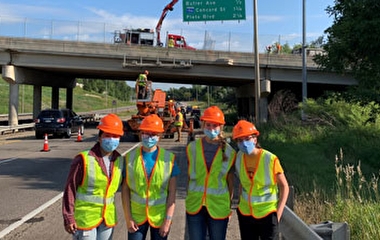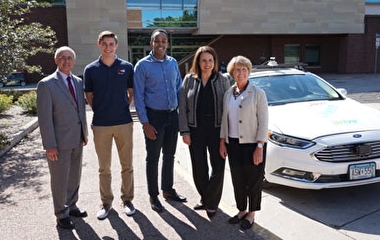This past summer, CTS hosted 24 students from two Chinese universities—Southeast University and Nanjing Tech University—for the inaugural offering of the Global Transit Innovations (GTI) Summer Training Program.
Focusing on transportation and urban planning, the program included academic courses, professional seminars, and site visits. It was developed by CTS, GTI, and the U of M China Center’s Mingda Institute. Plans for future years include attracting students from additional countries and offering opportunities for U of M students to study in China.
GTI was established last year by CTS in partnership with Associate Professor Yingling Fan of the Humphrey School of Public Affairs, who serves as GTI director.
GTI has a growing research and education portfolio. For example, Fan is developing a new book that will share lessons learned from her study of transit development in 20 U.S. metropolitan regions. The book will be a resource for training students and professionals. Fan shares highlights of recent work below.
Tell us about your book.
There is momentum for rail and bus rapid transit (BRT) corridors across U.S. metropolitan regions, but little data on how they succeeded despite long-standing fiscal, political, and sociocultural barriers for transit development in the car-centric U.S. The book will tell the story of how those infrastructure projects were built and offer original analyses on the societal impacts of existing and proposed corridors. Ultimately, the book will offer practical solutions on how to capitalize on emerging transit investments and maximize their positive impacts—i.e., get more bang for the buck.
Who is the intended audience?
The book is intended for planning practitioners and policymakers interested in creating more transportation options for metropolitan residents. Transit corridor development has a strong potential to make metropolitan regions more sustainable, livable, and equitable. Further, by integrating storytelling with rigorous empirical work, the book will be an interesting read for college students to learn about the challenges and opportunities of transit development in the U.S.
What are some highlights from your site visits?
To gather information for the book, I’m visiting cities and meeting with transit development leaders throughout the country. The field work and expert interviews have been extremely enlightening. I have learned about the large unmet demand for cross-town transit in the San Francisco Bay Area and how transit fragmentation in the region hurts ridership. I have learned how Dallas pioneered the use of abandoned railways for transit development and urban regeneration. I have also learned how Detroit and New York City initiated transit corridor projects largely on the promise of land development and without transit agencies playing a primary role—in essence, “development-oriented transit.” These unique case studies merit national and international attention.
What’s needed for a transit revival?
The future of transit will largely be shaped by our ability to create a regional collection of places connected by transit. These places must have quality public spaces with various economic, leisure, and socializing activity opportunities. Of course, public transit needs to provide mobility—but it also desperately needs a regional collection of transit-connected places to bump up demand. A transit revival requires regional and systematic integration of transit planning and place-making initiatives.
———————
The GTI website includes ongoing and completed research, publications, and profiles of current GTI researchers.



